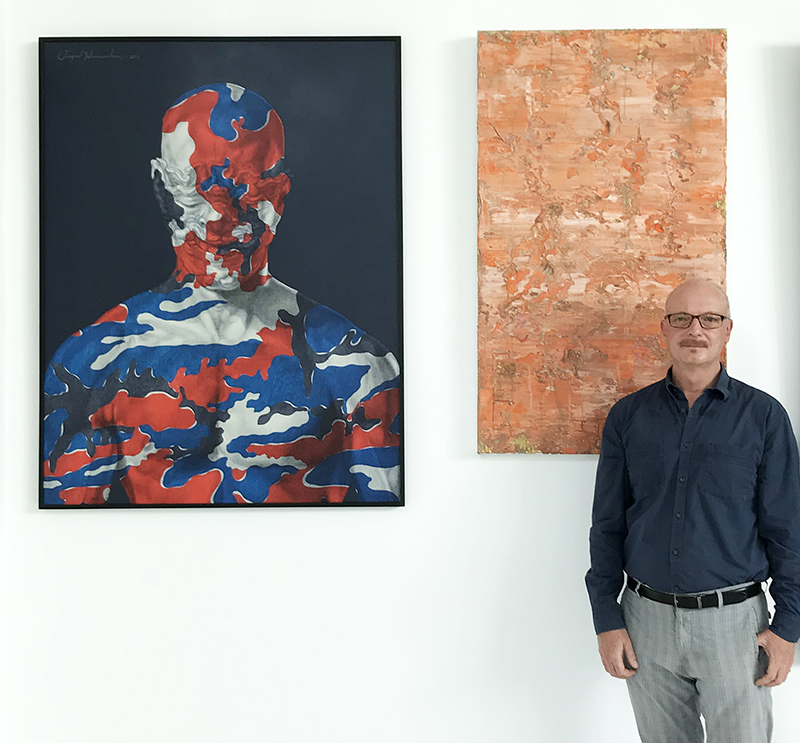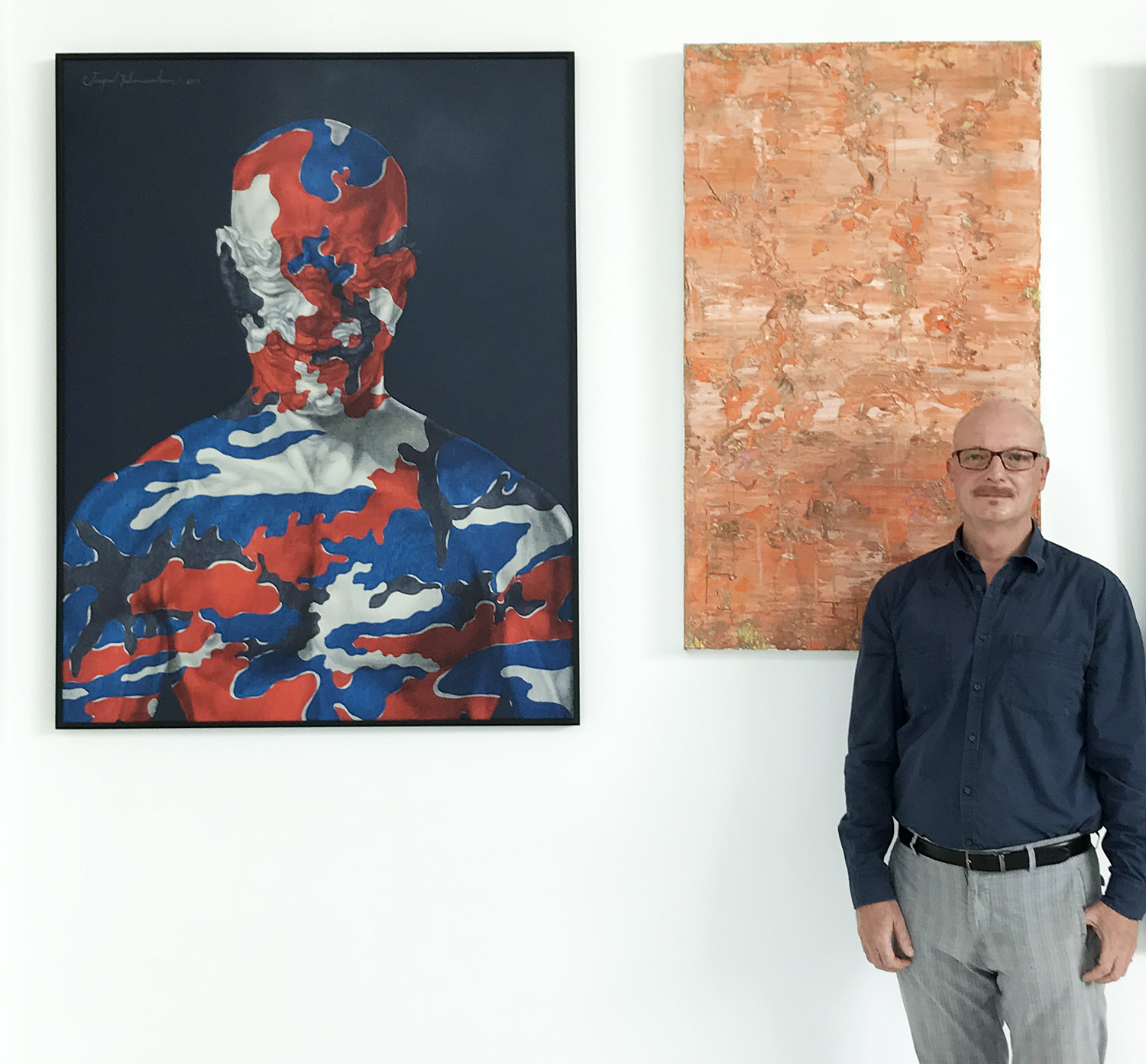Via the Thavibu Art Advisory, Jørn Middelborg seeks to take the art of Thailand, Vietnam and Myanmar far and wide.
I witnessed political performances in Yangon in the late 1990s by Nyein Chan Su, but they were soon shut-down by the government censors. All exhibitions had to be pre-approved and not only political exhibitions were banned, but also exhibitions where the censors did not understand the art in question, as in an exhibition of erotic or abstract paintings by MPP Yei Myint. It was a case of “better ban too much than too little”. During the 2000s I had to hand-carry and “smuggle” political paintings by Myint Swe from Yangon to Bangkok. Political works were produced in Myanmar, but in secret and under the radar.

Jørn Middelborg at the Thavibu Art Advisory, Bangkok. Far left is a painting by Jirapat Tatsanasomboon (Thai) entitled Mourning Thailand and which shows Nonthok – a character from the prelude to Ramakien (based on the Ramayana) – expressing sadness about the political infighting and finding comfort by wrapping himself in the colours of the Thai flag. The painting to the left is by Ha Manh Thang (Vietnamese) called Fading Spring – a multi-layered abstraction based on traditional birds and flowers paintings.
Let’s start at the beginning. Tell us what led to this journey with Southeast Asian art?
I came to Bangkok in 1994 to work for UNESCO. It was a job supporting non-formal education with the regional headquarters in Bangkok. I travelled quite extensively in the region and collected art, mostly paintings. I have collected on a small scale since I was a teenager, and I collected more extensively during my UNESCO assignment.
After a few years working for UNESCO, I had to make a decision whether to continue working with the organisation and move to another country, or stay in Thailand and do other work. I decided to stay and set up my own company, Thavibu Gallery, which got its name from the first letters of the countries: ‘tha’ from Thailand, ‘vi’from Vietnam, and ‘bu’ from Burma. I chose to specialise in these three countries since I was based in Thailand. Vietnamese art was booming in the late 1990s and Burmese, later Myanmar, contemporary art was almost completely unknown so I wanted to bring it to a wider audience. Thus, Thavibu was born focussing on contemporary art from these three countries. As the same time, the Internet came to the fore, and I launched a website in 1998, possibly the first gallery with a website in Southeast Asia, and we sold a painting online, to the USA in 1999, which I think was a first as well.
How do you describe yourself in the context of challenging people’s perspectives via your work?
I have seen my role perhaps first of all as an educator since I have been involved with education in various forms throughout my life. And in the same vein, to disseminate art to a wider audience.
What does your role at Thavibu involve?
When I ran Thavibu Gallery until 2016, I was the managing director and, thus, responsible for the direction of the gallery, planning activities and taking care of the tasks that a gallery director normally does. Upon closing Thavibu Gallery in 2016 and establishing Thavibu Art Advisory, my role became different. I currently do not organise exhibitions though I try to help artists I worked with earlier so they can continue to exhibit in other galleries or venues. As an art advisor, I now work with projects rather than exhibitions. Presently my projects have been collaborations with auction houses, museums, and collectors. I also do research. My current research is mostly focussed on old Burmese paintings.
What are your challenges while playing different roles? How do you balance the contradicting elements of your work?
Thavibu Gallery was a regular art gallery as we put on exhibitions, published catalogues and books, participated in international art fairs and so on. In addition to permanent gallery staff, I worked with curators to plan and implement exhibitions and projects. The curators I most often collaborated with include Shireen Naziree for Vietnamese and Burmese art and Steven Pettifor for Thai art, though I collaborated with a few other curators as well. Steven Pettifor is the author of the book Flavours – Thai Contemporary Art, and I am pleased that we managed to pull it all together – writing, financing and publishing – as it has been recognised as a milestone publication on Thai contemporary art.
What are you looking for when you review artists’ work? How does it all come together?
When I meet a new artist and see his or her works, one always assesses the visual impact based on previous experiences. I listen as much as possible to the input from curators and other artists and read about the artist. It has been important for me to show works that include a broad spectrum of subjects and approaches, from abstractions to the political. Personally I have a fondness for narrative works.
How does the market interact and react to the unexpected vis a vis your work?
A gallery’s work is related both to the art and to the market. They are inter-dependent factors and both need attention from the gallery. When I planned exhibitions, the commercial aspect was always secondary. You cannot set up a show in which the priority is to sell.
You have spent a lot of time amongst artists in flow. What have you observed?
Based on my long-time observations and collaborations with artists, I would say that it is often hard to be an artist. Income can be erratic and it is difficult to plan for the future, even for the present. There is also constant pressure from the market and from curators and viewers for the artist to perform and to innovate. In the end, several artists survive financially by having additional jobs.
How does the art world look through your eyes? Let’s talk about your long-term vision. Would it be safe to say that Thavibu is a step towards manifesting this vision?
I would say that there is not one art world, but many art worlds. You have successful artists, and those who struggle; you have full time artists and some who work part-time; you have experimental artists and more commercial artists, and so on. I do not see “commercial” as something negative. The artist needs to survive financially, and all the artists I know are happy when their works sell. My long term vision is to bring the art out to a wide audience and make the art speak for itself, and hopefully educate people to be better human beings and give them a better understanding of society and of themselves.
Which shows, performances and experiences have shaped you? Who are your maestros?
I am a bit of an outsider since I do not have a degree in art education. I have an MSc degree and have worked with natural sciences and international education before I opened the gallery. On the other hand, contemporary Southeast Asian art happened along the way. One could not read a textbook on the subject in the 1990s, and I am fortunate to have been able to observe the development and progress as we went along. I have learned much from my Southeast Asian artist friends, and will continue to support their works as they deserve to be better known and more visible in today’s very competitive art world.
Tell us about your own personal evolution, vis-à-vis the work that you do. What have you observed about the changing cultural landscape over time?
Let me mention Myanmar as an example of how things have changed. I witnessed political performances in Yangon in the late 1990s by Nyein Chan Su, but they were soon shut-down by the government censors. All exhibitions had to be pre-approved and not only political exhibitions were banned, but also exhibitions where the censors did not understand the art in question, as in an exhibition of erotic or abstract paintings by MPP Yei Myint. It was a case of “better ban too much than too little”. During the 2000s I had to hand-carry and “smuggle” political paintings by Myint Swe from Yangon to Bangkok. Political works were produced in Myanmar, but in secret and under the radar. Performance art blossomed as this is an art form that could happen anywhere, as in someone’s house, and on a short notice to avoid the censors. Another hurdle in Myanmar was that the universities were closed for several years and the art education which took place was limited and of poor quality. The artists often relied on learning from each other, and from time to time they received foreign artists as visitors who could hand over art books and provide some input. All this has changed considerably since no pre-approval is necessary, and most subjects are allowed. Still though, overtly political or sexual works aren’t allowed.
Before you go – you might like to browse the Asian Curator curatorial archives . Contemporary art curators and international gallerists define their curatorial policies and share stories and insights about the inner runnings of the contemporary art world.












Add Comment